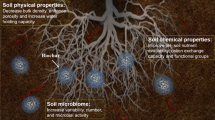Summary
Boron and molybdenum as trace elements and ammonium sulphate and sodium nitrate as nitrogen sources, affected the rate of composting of wheat straw in the laboratory. The nitrogen sources were used at rates to add 1 per cent nitrogen to the straw. With sodium nitrate the optimum concentration of molybdenum was 5.0 p.p.m.; with ammonium sulphate it was 1 p.p.m. Maximum loss of dry matter in 60 days was 50 per cent which was obtained with sodium nitrate and 1 p.p.m. added boron. There was inhibitory or toxic effect with the trace element additions beyond an optimum level. Whether or not additions of boron and molybdenum as an aid to rapid composting are desirable will depend upon concentrations in the organic wastes, nitrogen sources, inoculum, and water employed. The role of trace elements in bacterial enzyme systems is well known but more detailed experiments are needed o establish their requirements. Although it is generally regarded that the plant materials have enough trace elements to take care of their decomposition, this study suggests that there is a definite need to supply additional doses for rapid composting, as the additions of all the concentrations of molybdenum and boron showed more losses of dry matter, total carbon, and conservation of total nitrogen over the control at all the periods under study.
Abstract
Бор и молибдеп в качестве микроэлементов, а также серпокислый аммоний и азотнокислый натрий в качсетве источников азота оказывали влияние на скорость компостирования пшеничной соломы. Источники азота применялись в таком количестве, что к соломе был прибавлен 1% азота. В опытах с азотнокислым натрием оптимальпая концентрация молибдена составляла 5 р. p. m., с сернокислым аммонием – 1 р. p. m. Максимальное уменьшение количества сухого вещества через 60 дней составляло 50% и было отмечено с азотнокслым натриемпосле прибавления 1 p. p. m. Бора. За пределами оптимального уровня наблюдалось угнетающее или токсическое действие прибавления микроэлемента. Вопрос, целсообразно ли нбавление бора имолибдсна для ускорения компостирования, зависит от их концентрации в органических остатках, в источниках азота, в инокулюоме и в применяемой воде. Значение микроэлементов в энзиматических системах бактерий хорошо известно, но для определения их требований к микроэлементам необходимы более детальные опыты. Несмотря на общераспростаненый взгляд, что растительный материал содеожит достаточное количество микрозлементов для оьеспечения его разложния, предлагаемая работа говорит о том, что для быстрого кобавлять известные их количества, так как во всех применявшихся концентрациях бор и молибден вызывали более значтельныс потерн сухого вещества и общего углерода иконсрвирование более значительного количества общего азота, чем в контроле.
Similar content being viewed by others
References
Association of Official Agricultural Chemists:Official Methods of Analysis. Ed. 8, p. 30. Washington D.C. 1955.
Halverson, W. V., Torgenson, B. F.:Production of artificial farmyard manure by fermenting straw. J. Amer. Soc. Agron. 19: 577, 1927.
Heukelekian, D., Waksman, S. A.:Carbon and nitrogen transformations in the decomposition of cellulose by filamentous fungi. J. biol. Chem. 66: 323, 1925.
Hewitt, E. J.:The role of mineral elements in plant nutrition. Ann. Rev. Plant Physiol. 2: 25, 1951.
Hutchinson, H. B., Richards, E. H.:Artificial Farm Yard Manure. J. Ministry Agr. 28: 198, 1921.
Jensen, H. L.:On the influence of the carbon: nitrogen ratios of organic materials on the mineralization of nitrogen. J. Agr. Sci. 19: 71, 1929.
McElroy, W. D., Nason, A.:Mechanism of action of micronutrient elements in enzyme systems. Ann. Rev. Plant Physiol. 5: 1, 1954.
McGarity, J. W., Gilmour, C. M. and Bollen, W. B.:The use of an electrolytic respirator to study denitrification in soil. Can. J. Microbiol. 4: 303, 1958.
Mulder, E. G.:The essentiality of trace elements for microorganisms and the microbiological determination of these elements. Int. Congr. Microbiol. 6: 293, 1953.
Mulder, E. G.:Molybdenum in relation to growth of higher plants and microorganisms. Plant and Soil 5: 300, 1954.
Nason, A.:The function of metal in enzyme systems. Soil Sci. 85: 63, 1958.
Norman, A. G.:The biological decomposition of plant materials. Ann. Appl. Biol. 17: 575, 1930; 18: 244, 1931; 20: 146, 1933; 21: 454, 1934.
Rege, R. D.:Biochemical decomposition of cellulosic materials, with special reference to the action of fungi. Ann. appl. Biol. 14: 1, 1927.
Robinson, G. W., McLean, M. A. W., Williams, R.:The determination of organic carbon in soils. J. Agr. Sci. 19: 315, 1929.
Saraswathi-Devi, L.:Heavy metal requirements of fungi. Proc. Indian Acad. Sci. 41: 145, 1955.
Shrikhande, J. G.:The production of mucus during the decomposition of plant materials. Biochem. J. 27: 1551, 1933.
Shrikhande, J. G.:Determination of ammonical and nitrate nitrogen in decomposed plant materials. Ind. Eng. Chem. (Anal. Ed.) 13: 187, 1943.
Sui, R. G. H., Reese, E. T.:Decomposition of cellulose by microorganisms. Botan. Rev. 19: 377, 1953.
Waksman, S. A.:The microbiology of cellulose decomposition and some economic problems involved. Botan. Rev. 6: 637, 1940.
Yogeswari, L.:Trace element nutrition of fungi. Proc. Indian Acad. Sci. 28: 177, 1948.
Zayed, M. N.:Biological and chemical studies in rice straw compost. Ph. D. Thesis, University of Cairo, 1969.
Author information
Authors and Affiliations
Additional information
Most of the experimental work was carried out at the Government Agricultural College, Kanpur, India, and was supported by a fellowship grant to the senior author from the U.P. Scientific Research Committee and Government of India, Ministry of Education, Scholarship Division. Thanks are also due to Professor A. G. Norman, University of Michigan, Ann Arbor, U.S.A., for criticisms of the original manuscript.
Rights and permissions
About this article
Cite this article
Chandra, P., Shrikhande, J.G. & Bollen, W.B. The influence of trace elements on the composting of wheat straw. Folia Microbiol 7, 364–371 (1962). https://doi.org/10.1007/BF02928125
Received:
Issue Date:
DOI: https://doi.org/10.1007/BF02928125




